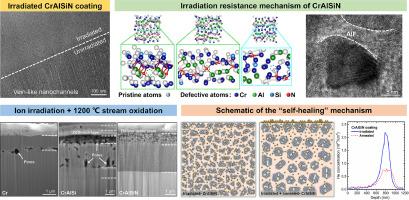当前位置:
X-MOL 学术
›
J. Mater. Sci. Technol.
›
论文详情
Our official English website, www.x-mol.net, welcomes your
feedback! (Note: you will need to create a separate account there.)
Enhancing the radiation- and oxidation-resistance of Cr-based coatings via structure regulation and composition optimization
Journal of Materials Science & Technology ( IF 11.2 ) Pub Date : 2024-10-22 , DOI: 10.1016/j.jmst.2024.08.051 Renda Wang, Nabil Daghbouj, Ping Yu, Peng Li, Fanping Meng, Antonio Cammarata, Bingsheng Li, P. Bábor, Tomas Polcar, Qing Huang, Fangfang Ge
Journal of Materials Science & Technology ( IF 11.2 ) Pub Date : 2024-10-22 , DOI: 10.1016/j.jmst.2024.08.051 Renda Wang, Nabil Daghbouj, Ping Yu, Peng Li, Fanping Meng, Antonio Cammarata, Bingsheng Li, P. Bábor, Tomas Polcar, Qing Huang, Fangfang Ge

|
Cr coatings, as protective coatings of Zr-alloy fuel claddings, inevitably suffer from irradiation damage before they would possibly run into the accident condition. This study evaluates the radiation and oxidation tolerance of three Cr-based coatings with different microstructures (Cr, CrAlSi, and CrAlSiN) through He2+ ion irradiation and 1200 °C steam oxidation. The Cr and CrAlSi coatings experienced significant structural degradation, characterized by He bubble aggregation and amplified Kirkendall effects at elevated temperatures. In contrast, the irradiated CrAlSiN coating maintained structural integrity without measurable irradiation hardening. Following annealing at 800 °C for 30 min, approximately 40 % of injected He atoms were released, indicating a “self-healing” mechanism. The mechanism is attributed to uniformly distributed, low-density channels that act as sinks and release paths for irradiation-induced defects. Density functional theory simulations suggest that N atoms promote significant rearrangement of ions surrounding the free volume, inhibiting the formation of sites capable of trapping He atoms. Moreover, the CrAlSiN coating exhibited superior oxidation resistance compared to the Cr and CrAlSi coatings, even under high-temperature steam conditions. Notably, the irradiated CrAlSiN sample displayed a significantly thinner oxide scale compared to the pristine one (almost half), owing to a more protective oxide scale and rapid outward diffusion of Cr, Al, and Si through nanochannel veins. These findings illuminate the effects of structure and composition on irradiation and oxidation behavior in Cr-based coatings, offering insights for developing new-generation accident-tolerance fuel coatings for Zr-alloy claddings.
中文翻译:

通过结构调控和成分优化增强 Cr 基涂层的抗辐射性和抗氧化性
Cr 涂层作为 Zr 合金燃料包壳的保护涂层,在可能进入事故状态之前不可避免地会受到辐照损伤。本研究通过 He2+ 离子辐照和 1200 °C 蒸汽氧化评估了三种具有不同微观结构的 Cr 基涂层(Cr、CrAlSi 和 CrAlSiN)的辐射和抗氧化性。Cr 和 CrAlSi 涂层经历了显着的结构降解,其特征是 He 气泡聚集和高温下放大的 Kirkendall 效应。相比之下,辐照 CrAlSiN 涂层在没有可测量的辐照硬化的情况下保持了结构完整性。在 800 °C 退火 30 分钟后,释放出大约 40% 的注射 He 原子,表明存在“自愈”机制。该机制归因于均匀分布的低密度通道,这些通道充当辐照诱导缺陷的汇和释放路径。密度泛函理论模拟表明,N 原子促进自由体积周围离子的显着重排,抑制能够捕获 He 原子的位点的形成。此外,与 Cr 和 CrAlSi 涂层相比,CrAlSiN 涂层即使在高温蒸汽条件下也表现出优异的抗氧化性。值得注意的是,与原始样品相比(几乎一半),辐照后的 CrAlSiN 样品显示出明显更薄的氧化皮,这是由于更具保护性的氧化皮和 Cr、Al 和 Si 通过纳米通道脉的快速向外扩散。这些发现阐明了结构和成分对 Cr 基涂层辐照和氧化行为的影响,为开发用于 Zr 合金包层的新一代事故容忍燃料涂层提供了见解。
更新日期:2024-10-22
中文翻译:

通过结构调控和成分优化增强 Cr 基涂层的抗辐射性和抗氧化性
Cr 涂层作为 Zr 合金燃料包壳的保护涂层,在可能进入事故状态之前不可避免地会受到辐照损伤。本研究通过 He2+ 离子辐照和 1200 °C 蒸汽氧化评估了三种具有不同微观结构的 Cr 基涂层(Cr、CrAlSi 和 CrAlSiN)的辐射和抗氧化性。Cr 和 CrAlSi 涂层经历了显着的结构降解,其特征是 He 气泡聚集和高温下放大的 Kirkendall 效应。相比之下,辐照 CrAlSiN 涂层在没有可测量的辐照硬化的情况下保持了结构完整性。在 800 °C 退火 30 分钟后,释放出大约 40% 的注射 He 原子,表明存在“自愈”机制。该机制归因于均匀分布的低密度通道,这些通道充当辐照诱导缺陷的汇和释放路径。密度泛函理论模拟表明,N 原子促进自由体积周围离子的显着重排,抑制能够捕获 He 原子的位点的形成。此外,与 Cr 和 CrAlSi 涂层相比,CrAlSiN 涂层即使在高温蒸汽条件下也表现出优异的抗氧化性。值得注意的是,与原始样品相比(几乎一半),辐照后的 CrAlSiN 样品显示出明显更薄的氧化皮,这是由于更具保护性的氧化皮和 Cr、Al 和 Si 通过纳米通道脉的快速向外扩散。这些发现阐明了结构和成分对 Cr 基涂层辐照和氧化行为的影响,为开发用于 Zr 合金包层的新一代事故容忍燃料涂层提供了见解。


















































 京公网安备 11010802027423号
京公网安备 11010802027423号